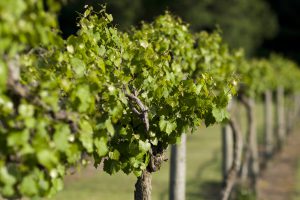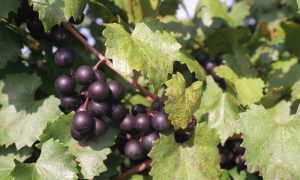
While citrus trees have long been a popular choice for home gardeners, let me introduce you to the delightful world of muscadine grapes—a refreshing alternative that may just make you reconsider your planting preferences. Muscadine grapes offer a range of advantages over citrus trees, starting with their remarkable resilience. These robust vines thrive in a variety of climates, from humid summers to chilly winters, making them adaptable and suitable for many regions. Additionally, muscadine grapes boast exceptional disease resistance, reducing the need for extensive pest control measures and making them a low-maintenance option. Not to mention, these grapes are bursting with flavor! Their unique, sweet-tart taste and juicy texture make them perfect for snacking, jams, jellies, or even homemade wines. Lastly, muscadine grapes offer the added benefit of being a versatile landscaping feature, with their sprawling vines providing shade and privacy.

Now, in the sunny state of Florida, where gardening enthusiasts often gravitate towards citrus trees, it’s time to consider the incredible potential of growing muscadine grapes in your home garden. Florida’s warm and sunny climate provides an excellent environment for cultivating a wide variety of fruits, and muscadine grapes are no exception. With their unique characteristics and abundant benefits, muscadine grapes can bring a fresh and flavorful twist to your garden.
In this article, we will explore the essential steps and considerations to help you successfully grow muscadine grapes in your Florida home garden. Whether you’re an avid gardener or a novice looking to embark on a fruitful endeavor, the journey of growing muscadine grapes is sure to be a rewarding one. So, if you’re seeking a fruitful and hassle-free gardening experience with a touch of sweetness, consider planting muscadine grapes as a delicious alternative to citrus trees.
Growing Muscadine Grapes
Right Plant
Before you begin, it’s crucial to select the right muscadine grape cultivar that is well-suited for your garden. UF/IFAS Extension places muscadine grapes in 2 categories: recommended cultivars and suggested for trial plantings. In this article, we will only cover recommended cultivars that are relatively easy to acquire and group them by usage.
- Cultivars for Fresh Market: Black Beauty, Fry, Southern Home, Summit, and Triumph
- Cultivars for Wine, Jellies, and Juices: Alachua, Carlos, Noble, and Welder
These cultivars are known for their disease resistance, productivity, and excellent flavor.

Right Place
Choosing the ideal site for your muscadine grape vines is key to their successful growth. Muscadines require full sun exposure (at least 6-8 hours of direct sunlight per day) to flourish. Look for a location in your garden that receives ample sunlight and has well-drained soil. Muscadines are tolerant of a wide range of soil types, but the soils are loamy sands and sandy loams.
Water Efficiently
Regular and consistent watering is essential for young muscadine grape plants. Provide enough water to keep the soil consistently moist but not waterlogged. Once the vines are established, they are more drought-tolerant but still benefit from regular watering during dry spells.
Pruning
Pruning is crucial for maintaining the health and productivity of muscadine grape vines. Prune during the dormant season, typically in late winter or early spring, to remove dead or weak wood and to shape the vines. Pruning helps improve airflow, sunlight penetration, and fruit quality.
Fertilize Appropriately
Muscadine grapes generally have moderate fertility requirements. Nevertheless, it is important to first find out soil pH and soil nutrients status prior to applying fertilizer. Apply a balanced fertilizer, such as a 10-10-10 formula, in early spring before new growth appears. Follow the recommended application rates on the fertilizer package. THE LABEL IS THE LAW.

Manage Yard Pests Responsibility
Muscadine grapes are relatively resistant to many pests and diseases. However, some common pests to watch out for include aphids, grape root borers, and grape berry moths. Regular inspection of the vines and prompt action can help prevent infestations.
Diseases such as downy mildew, powdery mildew, and black rot can affect muscadine grapes. To minimize the risk of disease, provide good airflow around the vines, avoid overhead watering, and promptly remove any infected plant material.

Harvesting and Enjoying Muscadine Grapes
Muscadine grapes typically ripen in late summer to early fall. They have a unique and robust flavor, often described as “wild” or “spicy.” Harvest the grapes when they reach their full color and can be easily plucked from the vine. Enjoy them fresh, make delicious preserves, or use them in various culinary creations.
Growing muscadine grapes in your Florida home garden can be a delightful and rewarding experience. By selecting the right varieties, providing proper care, and managing pests and diseases, you can enjoy a bountiful harvest of these unique and flavorful grapes. Embrace the opportunity to cultivate your own vineyard and savor the taste of these delicious fruits right in your backyard.
For more information on Muscadine Grapes click, https://edis.ifas.ufl.edu/publication/HS100
Interested in growing Muscadine Grapes in your home garden?
Join us for an unforgettable experience where you’ll not only learn the art of growing these delectable fruits, but also get a chance to handpick succulent grapes straight from the vine. Secure your spot now by clicking HERE and embark on a journey of fruitful delight! Click HERE!
 8
8
